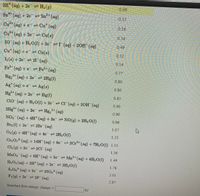
Chemistry
10th Edition
ISBN: 9781305957404
Author: Steven S. Zumdahl, Susan A. Zumdahl, Donald J. DeCoste
Publisher: Cengage Learning
expand_more
expand_more
format_list_bulleted
Concept explainers
Question
193.) The standard free energy change = blank

Transcribed Image Text:2H (ag) +2e = (g)
0.00
Sn (aq) + 2e Sn+ (aq)
0.15
(bo)
Cu (ag) + e = Cu* (aq)
0.16
Cu+ (ag) + 2e – Cu(s)
0.34
IO (aq) + H20(1) + 2e I (aq) + 20H (aq)
I (aq) + 20H (ag)
0.49
Cu* (ag) +e Cu(s)
0.52
L(s) + 2e 21 (ag)
0.54
Fe (aq) +e Fe²+ (aq)
0.77
Hg
2+ (ag) + 2e 2Hg(1)
0.80
Ag (aq) +e = Ag(s)
0.80
Hg²+ (aq) + 2e = Hg(!)
0.85
CIO (ag) + H,0(1) + 2e Cl (aq) + 20H (ag)
0.90
2Hg (aq) + 2e Hg, (aq)
2+
0.90
NO; (ag) + 4H* (ag) + 3e NO(g) + 2H20(1)
0.96
Br2 (1) + 2e 2Br (ag)
1.07
02 (g) + 4H (ag) + 4e 2H,0(1)
1.23
Cr2 O, (ag) + 14H (ag) + 6e H 2Cr** (aq) + 7H2O(1) 1.33
Cl2(g) + 2e 2C1 (aq)
1.36
MnO4 (ag) + 8H (aq) + 5e Mn2+ (aq) + 4H20(1)
1.49
H2O2 (aq) + 2H* (ag) + 2e - 2H20(1)
1.78
S20g (aq) + 2e = 2S0,2 (ag)
2.01
F2(g) +2e 2F (ag)
2.87
Standard free-energy change
kJ

Transcribed Image Text:Calculate the standard free-energy change at 25°C for the following reaction:
4Fe(s) + 302(9) + 12H* (aq) →4Fe (aq) + 6H,0(1)
6H,O(1)
Use standard electrode potentials.
Standard Electrode (Reduction) Potentials in Aqueous Solution at 25°C
Cathode (Reduction)
Half-Reaction
Standard
Potential, E" (V)
Lit (ag) + e Li(s)
-3.04
Na (ag) + e Na(s)
2.71
-
2+
Mg (ag) + 2e - Mg(s)
-2.38
Al* (aq) + 3e Al(s)
-1.66
2H20(1) + 2e = H2(g) + 20H (aq)
-0.83
Zn (aq) + 2e - Zn(s)
-0.76
Cr+ (ag) + 3e - Cr(s)
-0.74
Fe?+ (ag) + 2e = Fe(s)
-0.41
Cd²+ (aq) + 2e = Cd(s)
-0.40
Ni+ (ag) + 2e - Ni(s)
-0.23
Sn²+ (aq) +2e Sn(s)
-0.14
Pb (aq) + 2e Pb(s)
-0.13
Fe (ag) + 3e Fe(s)
-0.04
2H (aq) + 2e - H2(g)
0.00
Sn+ (ag) + 2e Sn2+ (ag)
0.15
Cu2+ (ag) + e Cu (aq)
0.16
Cu+ (ag) + 2e Cu(s)
0.34
I0 (aq) + H20(1)+2e I (aq) + 20H (ag)
0.49
Cu" (ag) +e = Cu(s)
0.52
I2 (8) + 2e 21 (ag)
0.54
0 77
Cengage Learning | Cengage Technical Sup
Expert Solution
This question has been solved!
Explore an expertly crafted, step-by-step solution for a thorough understanding of key concepts.
Step by stepSolved in 2 steps with 1 images

Knowledge Booster
Learn more about
Need a deep-dive on the concept behind this application? Look no further. Learn more about this topic, chemistry and related others by exploring similar questions and additional content below.Similar questions
- Explain the following terms:(i) Internal energy of a system(ii) Bomb calorimeterarrow_forwardwhat is the importance of studying heat of neutralization reactions? What is the basic theory of thermochemistry, including descriptions of q, h, and c? State the basic theory of constant pressure calorimetry.arrow_forwardThermochemistry is a branch of chemistry that qualitatively and quantitatively describes the energy changes that occur during chemical reactions. AH(T.) Products AH"(T) Reactants T, Temperature, T (i) Which Law of Thermochemistry is illustrated in the graph above (ii) Accurately define this Law with aid of appropriate equation/s. Enthalpy, Harrow_forward
- When the sign of an energy change is being determined, this would always be with respect to what?arrow_forwardA chemist measures the energy change AH during the following reaction: 2 Fe₂O3(s) 4 FeO(s) + O₂(g) 1 AH 560, kJ Use the information to answer the following questions. This reaction is... Suppose 25.9 g of Fe₂O3 react. Will any heat be released or absorbed? If you said heat will be released or absorbed in the second part of this question, calculate how much heat will be released or absorbed. Be sure your answer has the correct number of significant digits. endothermic exothermic OYes, absorbed. Yes, released. No. 0... X Garrow_forward1. State the first and second laws of thermodynamicsarrow_forward
arrow_back_ios
arrow_forward_ios
Recommended textbooks for you
 ChemistryChemistryISBN:9781305957404Author:Steven S. Zumdahl, Susan A. Zumdahl, Donald J. DeCostePublisher:Cengage Learning
ChemistryChemistryISBN:9781305957404Author:Steven S. Zumdahl, Susan A. Zumdahl, Donald J. DeCostePublisher:Cengage Learning ChemistryChemistryISBN:9781259911156Author:Raymond Chang Dr., Jason Overby ProfessorPublisher:McGraw-Hill Education
ChemistryChemistryISBN:9781259911156Author:Raymond Chang Dr., Jason Overby ProfessorPublisher:McGraw-Hill Education Principles of Instrumental AnalysisChemistryISBN:9781305577213Author:Douglas A. Skoog, F. James Holler, Stanley R. CrouchPublisher:Cengage Learning
Principles of Instrumental AnalysisChemistryISBN:9781305577213Author:Douglas A. Skoog, F. James Holler, Stanley R. CrouchPublisher:Cengage Learning Organic ChemistryChemistryISBN:9780078021558Author:Janice Gorzynski Smith Dr.Publisher:McGraw-Hill Education
Organic ChemistryChemistryISBN:9780078021558Author:Janice Gorzynski Smith Dr.Publisher:McGraw-Hill Education Chemistry: Principles and ReactionsChemistryISBN:9781305079373Author:William L. Masterton, Cecile N. HurleyPublisher:Cengage Learning
Chemistry: Principles and ReactionsChemistryISBN:9781305079373Author:William L. Masterton, Cecile N. HurleyPublisher:Cengage Learning Elementary Principles of Chemical Processes, Bind...ChemistryISBN:9781118431221Author:Richard M. Felder, Ronald W. Rousseau, Lisa G. BullardPublisher:WILEY
Elementary Principles of Chemical Processes, Bind...ChemistryISBN:9781118431221Author:Richard M. Felder, Ronald W. Rousseau, Lisa G. BullardPublisher:WILEY

Chemistry
Chemistry
ISBN:9781305957404
Author:Steven S. Zumdahl, Susan A. Zumdahl, Donald J. DeCoste
Publisher:Cengage Learning

Chemistry
Chemistry
ISBN:9781259911156
Author:Raymond Chang Dr., Jason Overby Professor
Publisher:McGraw-Hill Education

Principles of Instrumental Analysis
Chemistry
ISBN:9781305577213
Author:Douglas A. Skoog, F. James Holler, Stanley R. Crouch
Publisher:Cengage Learning

Organic Chemistry
Chemistry
ISBN:9780078021558
Author:Janice Gorzynski Smith Dr.
Publisher:McGraw-Hill Education

Chemistry: Principles and Reactions
Chemistry
ISBN:9781305079373
Author:William L. Masterton, Cecile N. Hurley
Publisher:Cengage Learning

Elementary Principles of Chemical Processes, Bind...
Chemistry
ISBN:9781118431221
Author:Richard M. Felder, Ronald W. Rousseau, Lisa G. Bullard
Publisher:WILEY